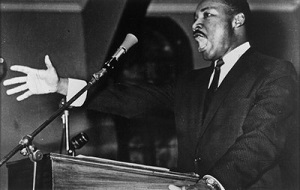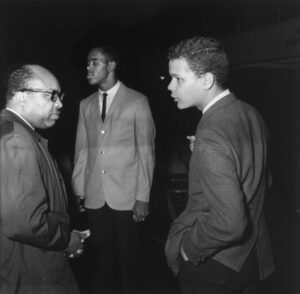The Museums Collections contain dozens of photographs by Prentice Herman (P. H.) Polk. These images document decades of life at the campus of Tuskegee Institute (now Tuskegee University), an important African American institution of higher learning that was founded by Booker T. Washington.
While the importance of photography to the Civil Rights Movement has been well documented, Polk's photographs provide a unique window into the fight for equal rights. As the institution's official photographer, Polk documented a range of events at Tuskegee, including the activities of the renowned Tuskegee Airmen and visits by Civil Rights leaders Martin Luther King, Jr. and Julian Bond.
Black members of the U.S. military played an important role in paving the way for future, broader desegregation efforts. The Tuskegee Airmen, the first African American aviators in the U.S. Army Air Corps, defied military leaders’ unfounded belief that African Americans did not have the mental capacity to become successful military pilots. Their service, along with the million other African Americans who served in the military during World War II, prompted the desegregation of the U.S. military. In 1947, President Harry S. Truman issued Executive Order 9981, which abolished discrimination on the basis of “race, color, religion or national origin” in the United States Armed Forces.
On July 31, 1955, Martin Luther King, Jr. gave a sermon entitled “The Three Dimensions of a Complete Life” at the Tuskegee Institute Chapel. Polk's photograph captures the renowned orator mid-word as he delivers the sermon. Later that year, King's role in the Montgomery bus boycott would propel him to national fame.
As a student at Morehouse College in Atlanta, Georgia, Julian Bond helped establish the Student Nonviolent Coordinating Committee (SNCC). From 1961 to 1966, he served as SNCC's communications director, where he worked to ensure that stories of student protests and voter registration drives received national media attention. This photograph of Bond (at right) was likely taken during that period.

![P. H. Polk, Untitled [Tuskegee Airman and Plane], 1941-45, gelatin silver print. Museums Collections P. H. Polk, Untitled [Tuskegee Airman and Plane], 1941-45, gelatin silver print. Museums Collections](https://exhibitions.lib.udel.edu/art-civil-rights/wp-content/uploads/sites/228/2020/08/Polk_Untitled-airman-with-plane-e1643837668378.jpg)


